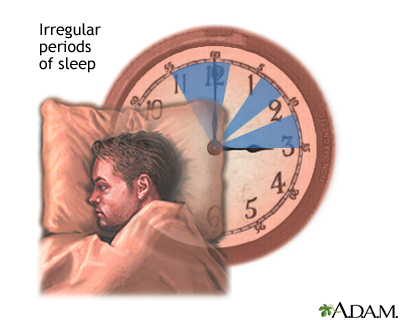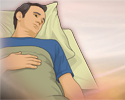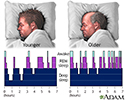Sleep disorders - overview
Insomnia; Narcolepsy; Hypersomina; Daytime sleepiness; Sleep rhythm; Sleep disruptive behaviors; Jet lag
Sleep disorders are problems with sleeping. These include trouble falling or staying asleep, falling asleep at the wrong times, too much sleep, and abnormal behaviors during sleep.
Causes
There are more than 100 different sleeping and waking disorders. They can be grouped into 4 main categories:
- Problems falling and staying asleep (insomnia)
- Problems staying awake (excessive daytime sleepiness)
- Problems sticking to a regular sleep schedule (sleep rhythm problem)
- Unusual behaviors during sleep (sleep-disruptive behaviors)
PROBLEMS FALLING AND STAYING ASLEEP
Insomnia includes trouble falling asleep or staying asleep. Episodes may come and go, last up to 3 weeks (be short-term), or be long-lasting (chronic).
Insomnia
Insomnia is trouble falling asleep, staying asleep through the night, or waking up too early in the morning. Episodes of insomnia may come and go or ...
PROBLEMS STAYING AWAKE
Hypersomnia is a condition in which people have excessive daytime sleepiness, meaning that they feel tired during the day. Hypersomnia can also include situations in which a person needs to sleep a lot. This may be due to other medical conditions, but can also be due to a problem in the brain. Causes of this problem include:
Hypersomnia
Idiopathic hypersomnia is a sleep disorder in which a person is excessively sleepy (hypersomnia) during the day and has great difficulty being awaken...

-
Medical conditions, such as
fibromyalgia
and low thyroid function
Fibromyalgia
Fibromyalgia is a common syndrome in which a person has long-term pain that is spread throughout the body. The pain is most often linked to fatigue,...
 ImageRead Article Now Book Mark Article
ImageRead Article Now Book Mark Article -
Mononucleosis
or other viral illnesses
Mononucleosis
Mononucleosis, or mono, is a viral infection that causes fever, sore throat, and swollen lymph glands, most often in the neck.
 ImageRead Article Now Book Mark Article
ImageRead Article Now Book Mark Article -
Narcolepsy
and other sleep disorders
Narcolepsy
Narcolepsy is a nervous system problem that causes extreme sleepiness and attacks of daytime sleep.
 ImageRead Article Now Book Mark Article
ImageRead Article Now Book Mark Article -
Obesity, especially if it causes
obstructive sleep apnea
Obstructive sleep apnea
Obstructive sleep apnea (OSA) is a problem in which your breathing pauses during sleep. This occurs because of narrowed or blocked airways.
 ImageRead Article Now Book Mark Article
ImageRead Article Now Book Mark Article
When no cause for the sleepiness can be found, it is called idiopathic hypersomnia .
Idiopathic hypersomnia
Idiopathic hypersomnia is a sleep disorder in which a person is excessively sleepy (hypersomnia) during the day and has great difficulty being awaken...

PROBLEMS STICKING TO A REGULAR SLEEP SCHEDULE
Problems may also occur when you do not stick to a regular sleep and wake schedule. This occurs when people travel between time zones and with shift workers who are on changing schedules, especially nighttime workers.
Disorders that involve a disrupted sleep schedule include:
-
Irregular sleep-wake syndrome
Irregular sleep-wake syndrome
Irregular sleep-wake syndrome is sleeping without any real schedule.
 ImageRead Article Now Book Mark Article
ImageRead Article Now Book Mark Article -
Jet lag syndrome
Jet lag syndrome
Circadian rhythm sleep disturbances; Jet lag disorder
Read Article Now Book Mark Article - Paradoxical insomnia (the person sleeps a different amount than they think they do)
- Shift work sleep disorder
- Delayed sleep phase, as in teenagers who go to sleep very late at night and then sleep until noon
- Advanced sleep phase, as in older adults who go to sleep early in the evening and wake up very early
SLEEP-DISRUPTIVE BEHAVIORS
Abnormal behaviors during sleep are called parasomnias. They are fairly common in children and include:
-
Sleep terrors
Sleep terrors
Night terrors (sleep terrors) are a sleep disorder in which a person quickly wakes from sleep in a terrified state.
Read Article Now Book Mark Article -
Sleepwalking
Sleepwalking
Sleepwalking is a disorder that occurs when people walk or do other activity while they are still asleep.
Read Article Now Book Mark Article - REM sleep-behavior disorder (a person moves during REM sleep and may act out dreams)
References
Kryger MH, Rosenberg R, Martin L, Kirsch D. Hypersomnolence. In: Kryger MH, Rosenberg R, Martin L, Kirsch D, eds. Kryger's Sleep Medicine Review . 2nd ed. Philadelphia, PA: Elsevier; 2015:section 4.
Sateia MJ. International classification of sleep disorders-third edition: highlights and modifications. Chest . 2014;146:1387-1394. PMID: 25367475 www.ncbi.nlm.nih.gov/pubmed/25367475 .
Wakefield TL, Lam DJ, Ishman SL. Sleep apnea and sleep disorders. In: Flint PW, Haughey BH, Lund VJ, et al, eds. Cummings Otolaryngology: Head & Neck Surgery . 6th ed. Philadelphia, PA: Elsevier Saunders; 2015:chap 18.
-
Sleep disorders
Animation
-
Irregular sleep - illustration
Symptoms of sleep-wake syndrome include irregular periods of sleep and wakefulness which disrupt the normal daily sleep-wake cycle. It may be caused by brain dysfunction or not following a normal sleep schedule, ultimately leading to a pattern of insomnia and frequent daytime napping.
Irregular sleep
illustration
-
Sleep patterns in the young and aged - illustration
Sleep patterns change with age, anxiety levels and many other factors. Normally, younger people have more concentrated periods of deep sleep compared to older people.
Sleep patterns in the young and aged
illustration
-
Irregular sleep - illustration
Symptoms of sleep-wake syndrome include irregular periods of sleep and wakefulness which disrupt the normal daily sleep-wake cycle. It may be caused by brain dysfunction or not following a normal sleep schedule, ultimately leading to a pattern of insomnia and frequent daytime napping.
Irregular sleep
illustration
-
Sleep patterns in the young and aged - illustration
Sleep patterns change with age, anxiety levels and many other factors. Normally, younger people have more concentrated periods of deep sleep compared to older people.
Sleep patterns in the young and aged
illustration
-
Narcolepsy
(In-Depth)
-
Restless legs syndrome and related disorders
(In-Depth)
-
Fibromyalgia
(In-Depth)
Review Date: 1/27/2016
Reviewed By: Allen J. Blaivas, DO, Division of Pulmonary, Critical Care, and Sleep Medicine, VA New Jersey Health Care System, Clinical Assistant Professor, Rutger's New Jersey Medical School, East Orange, NJ. Review provided by VeriMed Healthcare Network. Also reviewed by David Zieve, MD, MHA, Isla Ogilvie, PhD, and the A.D.A.M. Editorial team.




